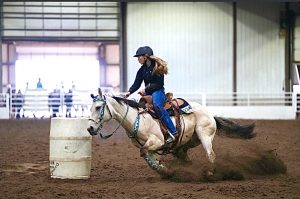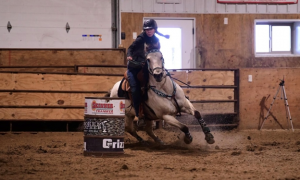Readers of The Echo, thank you for being here. This article is based around an interview I had with RCTC student and barrel-racing veteran, Grace Reed.
 Grace has been riding horses since she was 3, and began racing when she was just 11. In this interview, she schools me on some of the basics of the sport and its history. She also shares her personal connection with this exciting event.
Grace has been riding horses since she was 3, and began racing when she was just 11. In this interview, she schools me on some of the basics of the sport and its history. She also shares her personal connection with this exciting event.
Transcriptions from the interview have been lightly edited for clarity.
If you’ve never seen barrel racing, imagine doing an agility exercise, but instead of weaving through cones on foot, you’re navigating around 55-gallon barrels on horseback. The signature “cloverleaf” pattern involves a crucial 3-step maneuver to get your horse around the barrel without making the turn too round or sharp.
Grace says that the second-step, where you turn your horse around the barrel, is called your “pocket,” and something that confuses a lot of non-riders.
Something else that might seem foreign is the placement system, known as “the Ds.” As Grace describes it, it’s a dividing system, where racers are placed according to where they fall within half-second increments:
Me: And then yeah, it seemed kind of confusing. There was this concept of like, “the Ds”?
Grace: *Laughs at my obvious confusion* Oh yeah, the Ds.
Me: So you could like, you could have the second fastest time but not…
Grace: But you’re not gonna place, yep. So you got 1D, which is the best of the best. So you’re going to have the top time there. And then the 2D is going to be like a half second off that time. And then it keeps going in half second increments all the way down to five. And usually, it depends on the circuit you’re running, but they could place just the first two in each “D,” or they could place several down the line.
Later on, Grace also explained how horses are categorized based on what “D” you can expect them to fall in:
Grace: … a lot of horses can’t make it to higher levels, because they’re just plain not fast enough. So that’s actually another reason we have the 1D, 2D, 3D and 4D. It’s to have graded horses. So,say, “Oh this horse is a 1D horse. They’re going to consistently top the 1D.” Or you have a 2D horse, they’re consistently going to top 2D.
I also asked her about how the sport became predominantly practiced by women. She said that barrel racing and the cloverleaf pattern were actually introduced to give women a place in otherwise male-dominated rodeos (Originally, racers only made a figure eight around two barrels, until a third-barrel was introduced a few years later which created the cloverleaf pattern that is still used today).
The sport is now open to both men and women, but Grace says that the vast majority of riders are still women.
Another topic which piqued my interest was the difference between smaller and larger competitions. Grace says that for her, the true prize of racing comes from the training:
 Grace: As for accomplishments, I don’t place a whole lot of that on the showing side of it, it’s all like the training for me; because when I got my horse when I was 12, she was a two year old and she wasn’t broken in, she wasn’t trained at all. So I did all of that by myself. So that’s where I place all my accomplishment, is all the training.
Grace: As for accomplishments, I don’t place a whole lot of that on the showing side of it, it’s all like the training for me; because when I got my horse when I was 12, she was a two year old and she wasn’t broken in, she wasn’t trained at all. So I did all of that by myself. So that’s where I place all my accomplishment, is all the training.
While most riders in the smaller circuits share her love for training, nurturing, and raising horses, she says that methods used to train and race horses in big barrel racing raise a lot of ethical concerns for her.
This is what she had to say when I asked her if she had a favorite big barrel racer:
Grace: Not really, I don’t. A lot of the top barrel racers do things that I don’t really agree with. Like, I’m not a big fan of whips and stuff with horses. I think if your horse likes to run, it shouldn’t really need it. And from an ethical standpoint, there’s things in big barrel racing, just like horse racing, like drugging of horses, and there’s all that sort of stuff you have to account for. So I don’t look up to the big riders because I don’t know them well enough to know, “Hey, are you doing it right?” Or are you like, you know, cheatin? I call it cheatin’.
Grace says that in smaller circuits, rules are put in place to protect horses from any drug enhancements or physical abuse. For instance if a judge finds you carrying a whip, whether inside or outside the pen, you’ll get a warning. Get caught again and you can be banned from that show and others as well.
Finally, we touched on some the financial barriers that have kept barrel racing from becoming more mainstream. For instance, Grace mentioned that she has to pay for everything, including transportations costs (horse trailer, truck, gas, etc.) and entry fees. She said that while smaller circuits with lower entry fees help lessen the barrier, the number of racers remains inconsistent year to year.
It’s safe to say Grace keeps herself busy. She works at two different barns as a horse groomer, works security at the REC Center, is in the law enforcement program here at RCTC, and, of course, trains and competes as a barrel racer.
If you’d like to check out a race in-person, you can head to www.wsca.org for information on upcoming events.
Thank you all for reading, and a big thank you to Grace for being such a great interviewee!
Signing off,
Faraji
by Faraji Douglas
